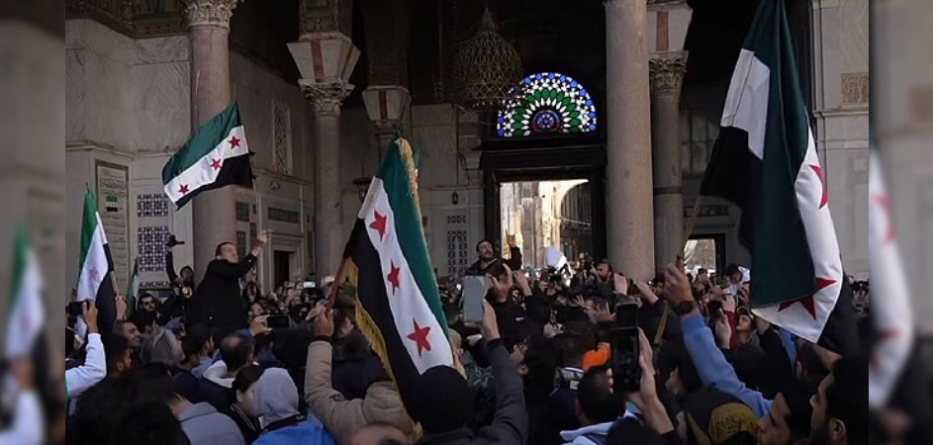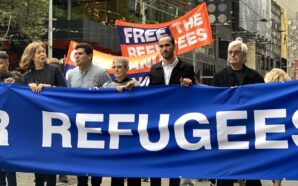Syria and Hezbollah
The events in Lebanon discussed in this article had a huge influence on what happened in Syria from November 27, 2024, onward. A well-organized and trained army of Islamist rebels from the small Syrian province of Idlib, bordering Turkey, reached the capital Damascus in less than two weeks, after taking Aleppo, Hama and Homs. They occupied it in an almost bloodless manner,[1] forcing President Bashar al-Assad to effect a hasty escape, organized by his Russian allies. The rebels are a mixed coalition, dominated by the jihadist group Hayat Tahrir al-Sham (“Organization for the Liberation of the Levant”), led by the charismatic Abu Mohammad al-Jolani. He was once affiliated with al-Qaeda and later joined the ranks of ISIS, from which he distanced himself ideologically and politically in 2017. In recent years he had governed Idlib in a competent but authoritarian manner.[2] Many of the opponents of the Assad regime had taken refuge there, under Turkish protection.[3] A few days after coming to power, al-Jolani abandoned his nom de guerre and used his own name, Ahmad al-Sharaa, replacing his militant Islamist uniform with a suit and tie. He claimed to have learned the lesson of past regime changes in the Arab world and did not want a “revolutionary” or bloody transition.
This change of government, unlike those in Iraq and Libya, was managed locally, rather than by foreign powers. Russia and Iran, who had previously been Damascus’ main supporters, discreetly withdrew from the conflict. There was also the failure of the Syrian army, which no longer wanted to fight for Assad, to put up any resistance. The new leader of Syria, which is still divided into many fiefdoms, has also declared that he wants to create an inclusive and democratic government to obtain the support of the West, and therefore the cancellation of sanctions. In particular, he addressed the Kurds, stating that they are “part of the homeland and partners of the future Syria,”[4] and also the Christians and Alawites, assuring them tolerance and freedom of worship.
Regarding the future of Syria, al-Sharaa promised to convene a national conference for dialogue, including all components of society, which will be entrusted with the task of drafting the new constitution.[5] But he also stated, correcting what he had said at the beginning, that it will take at least three years to complete this process and four years before calling for new elections, which would be held after a census of the population.
The new Syrian leader, speaking on Arab television about how he intended to exercise his power, emphasized that he would hold the reins of government firmly in his hands because “power sharing would destroy the transition phase.”[6] This statement can be interpreted in two different ways: either in the sense that this approach is necessary to create a democratic and modern Syria; or in the sense that a new autocracy would be established, this time Islamist. It is too early, however, to draw conclusions.
Another central focus of Syria’s new leader is the creation of a new national army based on the Idlib model. This step could be crucial in implementing al-Sharaa’s political aim of unifying a country that is divided in every respect. The defense minister of the interim government has stated that “the militias will be disbanded to form a single Syrian army. […] In every state, all military units must be integrated under the banner of the same institution.”[7] Al-Sharaa added that “every militia will come under the Ministry of Defense.”[8] This will include, of course, the Islamists, who will come under Hayat Tahrir al-Sham, and the Kurdish forces, supported by the USA, as Turkey is insistently requesting. According to many observers, this will not be easy to achieve.
Immediately after coming to power, al-Sharaa announced an amnesty for soldiers who had served in Assad’s army. Most of them had in fact been conscripted. Furthermore, a special list of hundreds of wanted persons has been drawn up, including Assad’s family members, ministers, senior officials, those responsible for massacres, as well as prison guards. Throughout the country there are “reconciliation centers” where ordinary citizens or soldiers can go, hand over any weapons in their possession and receive a certificate of pardon in exchange.
As mentioned, Russia and Iran are the big losers as a result of this insurrection. Iran, already hard hit by the Gaza war, has had to give up its geopolitical ambitions in the area that represented the “corridor” for its support for Hezbollah.[9] The so-called “axis of resistance,” which ran from the Houthis in Yemen to Hamas in Palestine, and on to Hezbollah in Lebanon, has been definitively broken. This means that in the future it will no longer be possible to supply arms to the Lebanese militia, which constituted Iran’s longa manus (extended reach) in the entire region.[10]
After Israel’s defeat of Hamas and Hezbollah, the rebels’ conquest of Syria was a clear sign of the decline of Iran’s influence in the region. It has been emphasized that the fall of Assad was a serious defeat for Tehran. In a few weeks, Iran’s geostrategic position shifted from the Mediterranean (i.e. Lebanon) to the western border of Iraq. Furthermore, the Ayatollahs evacuated all Iranian citizens and their own soldiers from Syria, while regional rivals Turkey and Israel quickly filled the vacuum left by their withdrawal.[11]
The Ceasefire between Israel and Hezbollah
A few months have passed since the ceasefire between Israel and Hezbollah and, despite frequent violations, it is still holding. In light of the events we have reported, it is likely that this truce will last a long time, despite everything. Clearly there are well-founded reasons, based on political or military realism, that are compelling both sides not to break the agreement.
It is important to remember the events that led the two parties to this decision, also the effects they have had on other geopolitical scenarios. After 14 months of war, on November 27, 2024, following long negotiations between Israel and Lebanon, together with the mediation of the USA and France, a ceasefire was reached between the Israeli army and the Hezbollah militia. The text proposed by Washington, through the mediation of Amos Hochstein, was not formally an “official agreement” between two countries (Israel and Lebanon), even if the negotiations were carried on by Israeli representatives and, on behalf of Hezbollah, by Nabih Berri, president of the Lebanese Parliament. In legal terms, this was simply a “framework agreement,” since, although approved by the competent state bodies, it was not countersigned, as required by the Constitution, by the Lebanese Head of State, since the post was vacant at the time.[12] In this article we will consider it – as indeed does the international community – as a real agreement. In fact, the legal issues mentioned in no way invalidate the effectiveness of this arrangement, which essentially aimed to silence the weapons on both sides.
The ceasefire of November 27th marked an important turning point in the complex Middle East crisis: first of all, the feared “second front of the war,” involving Hezbollah, was “weakened” and Israel was able to intervene as it pleased in Gaza, continuing to destroy and lay waste to a territory reduced to a “series of urban islands razed to the ground, ”[13] with a population exhausted by hunger, lack of medical resources and drinking water.[14] At the same time, a large, well-equipped army of Sunni jihadist rebels moved from Idlib to conquer Syria and occupied Damascus on December 8. This event was made possible above all by the military defeat of Hezbollah. In reality, it annihilated the so-called “axis of Shiite resistance” – of which Syria was a fundamental link – created in recent times by Tehran, which now has to rethink its strategic position in the region.
In fact, after the recent events that have changed the political geography of the Middle East, Syria may no longer support the Palestinian cause as it did in the past.[15] It is possible that in the future its strategic interests will be directed more toward Lebanon, which for Syria is the gateway to the Mediterranean. All the more likely because the Land of the Cedars is home to a large Shiite community, which still supports Hezbollah as a political party.
The Content of the Agreement
The content of the agreement of November 27, 2024, essentially repeats the text of UN Resolution 1701 of 2006, which had put an end to the earlier Israeli invasion of Lebanon. The agreement, which remained in force until January 26, 2024, was extended beyond the original deadline at the request of Israel and the USA. Tel Aviv cited the Lebanese armed forces’ inability to control the territory as the cause, while Beirut blamed the Israeli army’s unwillingness to leave the territory. In turn, Tsahal fired on the Lebanese, killing 22 people returning home, thus jeopardizing the truce.[16] The agreement stipulated that within 60 days Israel would withdraw from Lebanon and cease violating its land and air space. At the same time, Hezbollah was supposed to withdraw its weapons and militiamen beyond the Litani River, which is about 30 kilometers from the so-called “green line” (border). By January, southern Lebanon was supposed to be controlled by the Lebanese army with the collaboration of the UNIFIL blue helmets. Compared to 2006, the new text strengthened the role of the Lebanese army in the region and established international guarantors, such as the USA, Britain, France, Germany and others. Israel, in any case, claimed the right to intervene in the event of an “imminent threat” to its security.[17] Both parties had good reasons to accept the plan presented by the USA.[18]
As for Israel, Netanyahu himself gave some reasons in his televised speech on November 26. These included the need to concentrate on Iran, in order to “cut off the head of the Iranian snake,”[19] possibly with the endorsement and help of the USA, and to give some respite to an army exhausted after a year of fighting. Furthermore, continuing the war in Lebanon would mean expanding it, and the Israeli generals were reluctant to widen the war front and test an already exhausted army.[20]
But there were other reasons that had pushed Israel to this agreement. First of all, there was the desire to satisfy the American negotiators. In this way the Israeli government avoided tensions with the Biden administration, which was keen to achieve some goals in the Middle East, and at the same time to ingratiate itself with the new president Trump, who, during his election campaign, had promised Lebanese voters that he would soon put an end to the war in Lebanon.[21]
As for Hezbollah, its new secretary general, Naim Qassem, in his first speech after the ceasefire, had declared, repeating outdated slogans, that they had won the conflict with Israel because they had forced the most powerful army in the Middle East to retreat. “Ours is a divine victory,” he declared, “we have stopped the Zionists.”[22] In fact, he accepted the truce and committed himself to fully implementing the established terms.
At this point, one wonders what the future of Hezbollah will be after the agreement comes into force. Its leadership has been largely decimated; it has lost most of its advanced missile arsenal (about 70 percent),[23] and its military and welfare facilities have been bombed. Hezbollah and Hamas not only embrace political ideas, but are also structural organizations deeply rooted in the territory. Before October 7, 2023, they had thousands of employees working for them as militiamen, bureaucrats or activists. Hezbollah, in particular, was something of a state within a state: it managed patronage, ran a chain of cheap supermarkets and carried out welfare activities. Now these activities have been wiped out by the bombs. The future remains uncertain, and everything has to be rebuilt. Some analysts therefore fear for the future of these territories with the virtual disappearance of these two organizations. “It is not certain that Hamas will continue to be the main Palestinian military group or that Hezbollah will be the main representative of the Lebanese Shiites. The question is what could emerge to replace them. Many in Lebanon fear that a weakened Hezbollah could mean an internal struggle within the Shiite community. Even if it might not be under Hamas’ banner, as long as Israel denies the Palestinians a state, there will be Palestinians willing to fight Israel.”[24] Wise words that should make us think.
The 14-month war in Lebanon has been truly disastrous: there have been almost 4,000 deaths,[25] while the number of displaced persons preparing to return to their homes is around one and a half million. According to the World Bank, the war seems to have caused 8.5 billion dollars’ worth of damage, more than a third of Lebanon’s GDP.
A Truce for Gaza
The U.S. officials who had worked on the agreement with Lebanon hoped to extend this result in Gaza as well. According to the France Presse agency, at the end of November a Hamas leader had declared that the organization intended to reach a truce with its counterpart. U.S. Security Advisor Jake Sullivan had taken action in this regard and asked “his emissaries to contact Turkey, Qatar and Egypt to revive negotiations.”[26] Shortly afterward, they resumed in Qatar.
Finally, thanks to the mediation of the troika of negotiators (USA, Qatar and Egypt), an agreement on a ceasefire and the release of hostages was reached between Hamas and Israel. This came into effect on January 19th. Trump had been repeatedly threatening to “bring down hell” if the hostages were not released by the date he took office in the White House.[27] Both parties, especially Israel, have their own political motivations for not aggravating the new U.S. president. As for Biden, who did not intend to give up this political victory, the deadline for the release of the hostages was, on the other hand, “by the end of his term of office.”[28] One wonders why Netanyahu has only now accepted an almost identical agreement to that proposed to him last May. The answer is simple: accepting at the time would have caused an internal political crisis, while giving in to Trump’s pressure, despite the threats from the religious right, makes an end to the war more acceptable.[29] Furthermore, the goal he has repeatedly stated of completely eradicating Hamas has not been achieved. That this was the case was shown on January 15 when many members of the organization celebrated the ceasefire.[30]
The agreement, already announced months ago, has come into force in stages. There are three stages that should eventually lead to the end of the conflict. The first phase, which lasted 42 days, began with a ceasefire and the gradual withdrawal of Israeli troops from the territories and the entry of humanitarian aid into Gaza (about 600 trucks a day). In this phase, of the 98 hostages – how many of whom are still alive is unknown – 33 should be gradually released (at least three each week), with priority given to children, women and the sick. For each of these, between 30 and 50 Palestinian prisoners will be freed (about 2,000 in total), including life sentence prisoners, but not those who participated in the massacre of October 7. Withdrawal from the territories is one of the most delicate points of the agreement. The army has already prepared plans for the evacuation both from the Netzarim corridor (which divides the Strip in two) and from the Philadelphi corridor, on the border with Egypt. Israeli forces will gradually withdraw from the most densely populated areas of the Strip. They will retreat to the east, to a buffer zone along the border, which will be 700 meters from the frontier and can be extended to a maximum of another 400 meters.[31] The infrastructure will be dismantled, but this, as the generals say, will not prevent the army from returning if necessary.[32]
Starting from the sixteenth day of the truce, the negotiation of phase two (also lasting a month and a half) and phase three will begin. These should lead to the return of all those seized and a permanent ceasefire, and finally, a new administration in Gaza. “Here the process becomes hazy, the unknowns multiply and it is not known who will govern the Strip after Hamas.”[33] These steps, as past experience teaches us, are extremely delicate. In November 2023 it was precisely in this period of time that the weak agreement then collapsed.
Unfortunately the ceasefire came into effect at a time when almost everything in Gaza had already been destroyed, the population had been reduced to starvation, the buildings largely a pile of rubble, and about 47,000 Palestinians had died, many of them civilians. There is little to be happy about. One of the negotiators commented: “It’s not a good deal, but it’s better than no deal. It will take time and there will still be a lot of pain; but there is no other choice.”[34]
The Displaced in Lebanon and the Refugees in Syria
Another delicate problem at the moment, especially in Lebanon, is that of the displaced. The Lebanese seem ready to return to the south, to the homes they abandoned because of the war, while the Israelis – about 60,000 – are asking the government for more guarantees and are awaiting the practical consequences of the ceasefire. Among the refugees that have left Lebanon in recent months, the Syrians, about 500,000, deserve special attention. They had previously left Syria to escape the civil war. Some of them were Shiites and hoped, before the Islamists of al-Jolani took power in Syria, to be accepted by the Alawite Shiite minority.[35] In any case, the new leader of Syria has promised religious tolerance to all minorities, so the new arrivals should not fear any form of discrimination. Israel, however, views this exodus with suspicion and fears that many Hezbollah militiamen will move to Syria.
The former Syrian president had long considered the possibility of replacing the Sunni majority in the country, who had left the cities en masse at the height of the civil war, with more manageable minorities. In fact, his Alawite supporters represented only 10 percent of the population. In any case, hundreds of thousands of Shiites returning from Lebanon were welcomed by the regime that was now at an end. After Assad’s “escape” a new exodus of refugees from various regions of the Middle East to Syria has begun: Sunnis who fled persecution by the former dictator are returning to their country of origin.[36] Turkey, on the other hand, would like most of the Syrian immigrants in its territory – about four million – to return to Syria.
Immediately after Assad left the country and the Hayat Tahrir al-Sham militants entered Damascus, the Israeli army occupied the Syrian part of the Golan Heights,[37] a buffer zone between the two countries, encroaching on Syrian territory, claiming that this action was preventative, in order to guarantee Israel’s security. “To prevent hostile forces from setting up on our borders,” declared Prime Minister Netanyahu.[38] In addition, the Israelis bombed several military sites scattered throughout Syria, in order to destroy chemical weapons condemned by international conventions. In reality, Tel Aviv’s real fear is that they will end up in the hands of Islamic fundamentalists. In this regard, the new head of Syria has stated that Israel has “overstepped the limits of engagement”[39] with its military actions inside the country, which “represents an unjustified threat of escalation in the region.”[40] The hope is that in the future this stretch of territory, from which al-Sharaa’s family comes and to which his nom de guerre refers will not become the grounds for a new conflict.
Reproduced with permission by La Civilta Cattolica.
DOI: https://doi.org/10.32009/22072446.0325.2
[1]. Several hundred people died during this period, while the Syrian civil war, which began in 2011, caused around half a million deaths. Cf. “Syria has exchanged a vile dictator for an uncertain future”, in The Economist, December 12, 2024.
[2]. Cf. ibid.
[3]. Cf. “Who will rule Syria now the Assad regime has been toppled?”, in The Economist, December 12, 2024.
[4]. N. Del Gatto, “Israele, raid in Siria e nuovi insediamenti”, in La Stampa, December 16, 2024.
[5]. Cf. L. Cremonesi, “La Siria di Al Jolani. Quattro anni per votare”, in Corriere della Sera, December 30, 2024; G. Colarusso, “Siria: gli islamisti cambiano i libri di scuola. Gli attivisti insorgono: Deriva religiosa”, in la Repubblica, January 4, 2025.
[6]. L. Cremonesi, “La Siria di Al Jolani…”, op. cit.
[7]. L. Gambardella, “Per una Siria unita serve un esercito, dice Julani. Il modello Idlib”, in Il Foglio, December 19, 2024.
[8]. Ibid.
[9]. Cf. A. Melcangi, “L’Asse sciita è stato distrutto, Erdogan si è preso la rivincita e Israele ha un vicino jihadista”, in La Stampa, December 12, 2024.
[10]. Cf. P. Haski, “Vincitori e vinti in Siria”, in Internazionale, December 9, 2024.
[11]. Cf. “The fall of Bashar al-Assad is a blow for Iran”, in The Economist, December 11, 2024.
[12]. Cf. A. Nicastro, “Che cosa vuol dire il cessate il fuoco in Libano: cosa prevede e quali punti restano ambigui”, in Corriere della Sera, November 27, 2024.
[13]. G. Stabile, “Teheran salva l’alleato libanese e lascia Hamas al suo destino”, in La Stampa, November 27, 2024.
[14]. Cf. F. Mannocchi, “Natale a Gaza tra il gelo e la sete”, in La Stampa, December 24, 2024.
[15]. Cf. G. Stabile, “Teheran salva l’alleato libanese…”, op. cit.
[16]. D. Frattini, “Traballa la pace anche in Libano. Spari sulla gente in marcia verso casa”, in Corriere della Sera, January 27, 2025.
[17]. Cf. A. Nicastro, “Che cosa vuol dire il cessate il fuoco in Libano…”, op. cit.
[18]. Cf. P. Haski, “Netanyahu accetta la tregua in Libano per continuare la guerra a Gaza”, in Internazionale, November 27, 2024.
[19]. L. Caracciolo, “La guerra suicida di Israele”, in la Repubblica, October 23, 2024.
[20]. Cf. “Do Israel’s assassinations work?”, in The Economist, October 24, 2024.
[21]. Cf. “Israel and Hezbollah strike a fragile deal to end their war”, in The Economist, November 26, 2024.
[22]. “Chi è Naim Qassem, nuovo leader di Hezbollah”, in Il Sole 24 Ore, October 29, 2024.
[23]. Cf. M. Molinari, “Israele, la nuova strategia per frenare Erdogan in Siria e il nucleare degli ayatollah”, in la Repubblica, December 31, 2024.
[24]. “Do Israel’s assassinations work?”, op. cit.
[25]. The Israeli deaths in the war are apparently a few hundred. In any case, there are no official casualty lists.
[26]. D. Frattini, “I libanesi tornano nei villaggi al Sud. Anche Hamas vuole il cessate il fuoco”, in Corriere della Sera, November 28, 2024.
[27]. Cf. F. Magrì, “A Gaza l’ora della tregua. Hamas e Israele pronti al rilascio dei prigionieri”, in La Stampa, January 14, 2025, 2 f.
[28]. Ibid.
[29]. Cf. P. Haski, “Il futuro incerto di Gaza dopo il cessate il fuoco”, in Internazionale, January 16, 2025.
[30]. Cf. ibid.
[31]. Cf. F. Tonacci, “Stop ai combattimenti da domenica. Intesa a tappe sui rapiti e ritiro dell’Idf”, in la Repubblica, January 16, 2025, 2.
[32]. Cf. G. Fasano, “Le due fasi del patto e la ‘sospensione’: ma resta da definire il governo futuro”, in Corriere della Sera, January 14, 2025, 3.
[33]. F. Tonacci, “Stop ai combattimenti da domenica…”, op. cit.
[34]. F. Caferri, “Ostaggi, stop ai raid e aiuti. L’ultimatum di Trump sblocca il cessate il fuoco”, in la Repubblica, January 14, 2025.
[35]. Cf. “The world’s most unlikely safe haven”, in The Economist, November 10, 2024.
[36]. Cf. G. Colarusso – F. Tonacci, “Al valico tra Libano e Siria la coda infinita di chi torna e di chi scappa: Qui è cambiato tutto”, in la Repubblica, December 10, 2024.
[37]. Cf. “Exploiting disarray in Syria, Israel grabs more of the Golan Heights”, in The Economist, December 9, 2024.
[38]. R. Tercatin, “Israele nel Golan per la prima volta dal 1973: Invasione temporanea”, in la Repubblica, December 10, 2024. Netanyahu also stated: “This collapse is the direct result of our forceful action against Hezbollah and Iran, Assad’s main supporters” (ibid.).
[39]. N. Del Gatto, “Israele, raid in Siria e nuovi insediamenti”, op. cit.
[40]. Ibid.








